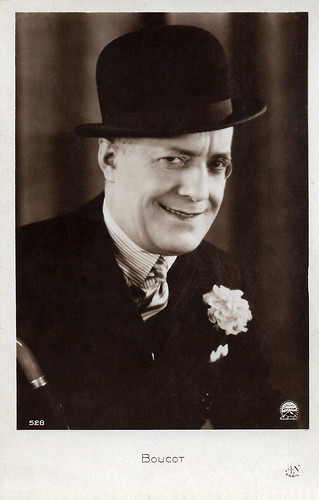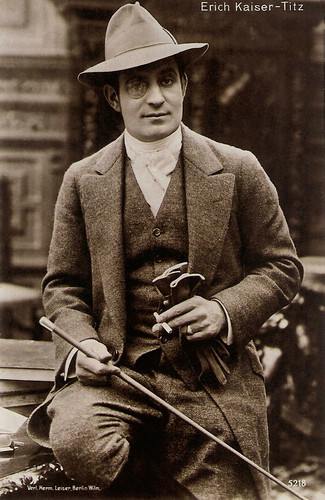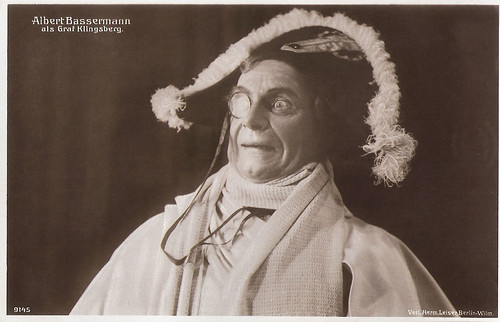
Spanish card by La Novela Semanal Cinematográfica, no. 78.
Was Austrian-born Erich von Stroheim (1885-1957) a Hollywood movie star or a European film star? (Who cares!) As the sadistic, monocled Prussian officer in both American and French films, he became ‘The Man You Love to Hate’. But maybe he is best known as one of the greatest and influential directors of the silent era, known for his extravaganza and the uncompromising accuracy of detail in his monumental films.

French postcard by A.N., Paris, no. 528. Photo: Paramount.
Louis-Jacques Boucot aka Boucot (1882-1949) was a French stage and screen actor, famous for his comic characters of Pénard and Babylas.

German postcard by Photochemie, Berlin, no. K. 2769. Photo: Freddy Wingardh. Asta Nielsen in the stage pantomime 'Der verlorene Sohn' (The Lost Son, 1918). Collection: Marlene Pilaete.
Danish silent film actress Asta Nielsen (1881-1972), was one of the most popular leading ladies of the 1910s and one of the first international film stars. Of her 74 films between 1910 and 1932, seventy were made in Germany where she was known simply as 'Die Asta'. Noted for her large dark eyes, mask-like face, and boyish figure, Nielsen most often portrayed strong-willed passionate women trapped by tragic consequences.

German postcard by Ross Verlag, Berlin, no. 3708/1, 1928-1929. Photo: Ufa.
Julius Falkenstein (1879-1933) was a bald, often monocle-wearing German character actor. He was known for such films as Zopf und Schwert - Eine tolle Prinzessin (1926), Der Meister von Nürnberg (1927) and Ich und die Kaiserin (1933).

German postcard by Ross Verlag, no. 1655/2, 1927-1928. Photo: Phoebus-Film. Elisabeth Bergner in Liebe/Love (Paul Czinner, 1927). Collection: Marlene Pilaete.
The profoundly sensitive acting of Austrian-British actress Elisabeth Bergner (1897-1986) influenced the German cinema of the 1920s and 1930s. She specialized in a bisexual type that she portrayed in Der Geiger von Florenz and in other film and stage roles. Nazism forced her to go in exile, but she worked successfully in the West End and on Broadway.

American postcard by Fotofolio, New York, N.Y., no. P124. Photo: Ufa / The Mansell Collection.
Fritz Lang (1890-1976) was an Austrian-German-American filmmaker, screenwriter, and occasional film producer and actor. One of the best-known émigrés from Germany's school of Expressionism, he was dubbed the 'Master of Darkness' by the British Film Institute. Lang's most famous films include the groundbreaking futuristic Metropolis (1927) and the influential M (1931), a film noir precursor that he made before he moved to the United States. His other notable films include Dr. Mabuse, der Spieler/Dr. Mabuse the Gambler (1922), Die Nibelungen (1924), Fury (1936), You Only Live Once (1937), Hangmen Also Die! (1943), The Woman in the Window (1944), and The Big Heat (1953).

German postcard by Verlag Hermann Leiser, Berlin-Wilm., no. 5218.
Erich Kaiser-Titz (1875-1928) was an actor in the German silent cinema of the 1910s and 1920s, playing in almost 300 films.

German postcard by Ross Verlag, no. 6307/1, 1931-1932. Photo: Atelier Jacobi, Berlin.
Austrian opera singer Richard Tauber (1891-1948) was one of the world's finest Mozartian tenors of the 20th century. Some critics commented that "his heart felt every word he sang". He also tested the then new talking pictures in such popular musical films as Ich küsse Ihre Hand, Madame (1929) with Marlene Dietrich, Das Land des Lächelns (1930) and Melodie der Liebe (1932).

French postcard by Editions Cinémagazine, no. 365.
Camille Bardou (1872-1941) was a French stage and screen actor, who acted in cinema between 1904 and 1934.

German collectors card by Ross Verlag in the series Vom Werden Deutscher Filmkunst - Der Stumme Film, picture no. 118, Group 39. Photo: Ufa. Publicity still with Henny Porten and Ralph Arthur Roberts in Meine Tante - deine Tante (Carl Froehlich, 1927).
With his monocle, German film actor Ralph Arthur Roberts (1884–1940) played high-ranking gentlemen such as directors and entrepreneurs in German comedies of the 1920s and 1930s. He also worked as a film director, creative director, and screenwriter for German cinema. He wrote stage plays and was the director of the Theater in der Behrenstrasse in Berlin. However, he is best known for a song he wrote, the evergreen 'Auf der Reeperbahn nachts um halb eins' (I May Never Go Home Anymore).

Austrian postcard by Iris Verlag, no. 6037. Photo: Terra Film / Götz Hofbauer.
Austrian-born stage and film actor and theatre director Fritz Kortner (1892-1970) was one of the best-known character actors of German silent cinema. His specialty was playing sinister and threatening roles.

German postcard by Verlag Hermann Leiser, Berlin-Wilm., no. 9145. Albert Bassermann as Graf Klingsberg in the play 'Die beiden Klingsberg' by August von Kotzebue.
Albert Bassermann (1867–1952) was one of the first great German stage actors who worked for the cinema. In 1933 he fled the Nazi regime and became an Oscar-nominated stage and film actor in the US.

French postcard by Cinémagazine-Edition, Paris, no. 235.
Diana Serra Cary (1918), best known as Baby Peggy, was one of the three major American child stars of the Hollywood silent movie era along with Jackie Coogan and Baby Marie. The first film, Playmates in 1921, was a success, and Peggy was signed to a long-term contract with Century Studios. Between 1921 and 1923 she made over 150 short comedies for Century. In 1922 she received 1.2 million fan letters and by 1924 she had been dubbed 'The Million Dollar Baby' for her $1.5 million a year salary.

German postcard by Ross Verlag, no. 1408/4, 1927-1928. Photo: Fayer, Wien.
Conrad Veidt (1893–1943) was the most highly strung and romantically handsome of the German expressionist actors. From 1916 until his death, he appeared in well over 100 films, including such classics as Das Kabinett des Dr. Caligari/Das Cabinet des Dr. Caligari (Robert Wiene, 1920) and Casablanca (Michael Curtiz, 1942).

French postcard by Publications J.P., Paris, no. 7. Illustration: Cabrol.
Max Dearly (1874-1943) was a French actor, famous for his parts in 1930s French sound film but also for his previous career in Parisian vaudeville.

German postcard by Ross Verlag no. 3528/1, 1928-1929. Photo: Ufa.
Rudolf Klein-Rogge is best remembered as Fritz Lang's Dr. Mabuse and as Lang's mad scientist in Metropolis, but he played many more parts in the German cinema.

British postcard in the Film Partners Series by Real Photograph, London, no. 81. Photo: British & Dominions. Ralph Lynn and Winifred Shotter.
British actor Ralph Lynn (1882-1962) was a tweedy, dark-haired comedian who made a stage career out of playing monocled silly ass twits. He was a veteran performer of London's highly popular Aldwych Repertory Theatre farces, and he and fellow members Tom Walls and Robertson Hare successfully took many of their stylized productions to the big screen in the 1930s.

German postcard by Ross Verlag, no. 1223/2. Photo: Alex Binder.
Austrian-born stage actress Mady Christians (1892-1951) was a star of the German silent cinema and appeared in Austrian, French, British, and Hollywood films too.
Sources: Wikipedia and IMDb.
1 comment:
I just loved this one! BIG fan of von Stroheim!
Post a Comment